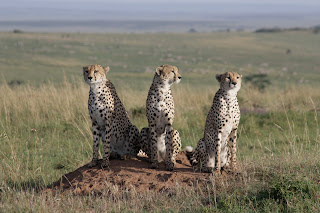Maasai Mara is
known as Africa’s Greatest Wildlife Reserve, situated in southwest Kenya. It lies in the
Great Rift Valley, breath taking
scenery which stretches through Kenya, Tanzania, and Malawi and into Mozambique.
Here the valley is wide and a towering escarpment can be seen in the obscure
distance. Famous for the abundance of lion,
the Great Wildebeest Migration and the Maasai people; well known for their
distinctive custom and dress; it is without a doubt that one of Africa’s most
famous safari destinations.
The Maasai Mara is magnificent, home to Kenya's richest concentration of wildlife, and regarded by many travelers as an essential stop on any tour of Africa and often admits that the Masai Mara is one of their favorite places. When westerners think of Africa and safari, this is the place they imagine - golden grassland plains pocked with acacia, lions, wildebeests, zebras, and jackals bound together by the cycle of life and death.
Maasai Mara National Reserve stretches 1,510 sq. km (580 sq. miles) and raises 1,500-2,170 meters above sea level. The terrain of the reserve is primarily grassland and riverine forest with clumps of the distinctive acacia trees. It’s about 270 km from the capital city Nairobi and takes about 5-6 hours by road and 40-45 minutes by flight.
The Maasai Mara is magnificent, home to Kenya's richest concentration of wildlife, and regarded by many travelers as an essential stop on any tour of Africa and often admits that the Masai Mara is one of their favorite places. When westerners think of Africa and safari, this is the place they imagine - golden grassland plains pocked with acacia, lions, wildebeests, zebras, and jackals bound together by the cycle of life and death.
Maasai Mara National Reserve stretches 1,510 sq. km (580 sq. miles) and raises 1,500-2,170 meters above sea level. The terrain of the reserve is primarily grassland and riverine forest with clumps of the distinctive acacia trees. It’s about 270 km from the capital city Nairobi and takes about 5-6 hours by road and 40-45 minutes by flight.
The Maasai Mara Ecosystem holds one of the highest lion densities in the world and this is where over two million Wildebeest, Zebra and Thomsons Gazelle migrate annually. Its hosts over 95 species of mammals and 570 recorded species of birds. Perhaps it is because of the 'big skies', the open savannahs, the romance of films like 'Out of Africa' and certainly because of the annual wildebeest migration, the density of game, the variety of birdlife and the chance of a hot air balloon ride. A combination of all these things plus something to do with the spirit of the place - which is hard to put into words - is what attracts people to the Mara over and over.
There are four types of topography in the Maasai Mara
- Mara Triangle bordering the Mara River with lush grassland and acacia woodlands supporting masses of game especially migrating wildebeest.
- Ngama Hills to the east with sandy soil and leafy bushes liked by black rhino.
- Central Plains forming the largest part of the reserve, with scattered bushes and boulders on rolling grasslands favoured by the plains game.
- Oloololo Escarpment forming the western boundary and rising to a magnificent plateau.
Best time to visit
Maasai Mara
The months
of December - March and July
- October have very pleasant weather and are by far the best
months to visit the Masai Mara National Reserve. April through June is also
good months but might be rainy or cool. July to October is dry and the grass is long and lush after the rains. This
is a good time to come and see the huge herds of migratory herbivores.
 |
| The Great Wildebeest Migration in Maasai Mara |

















0 comments:
Post a Comment